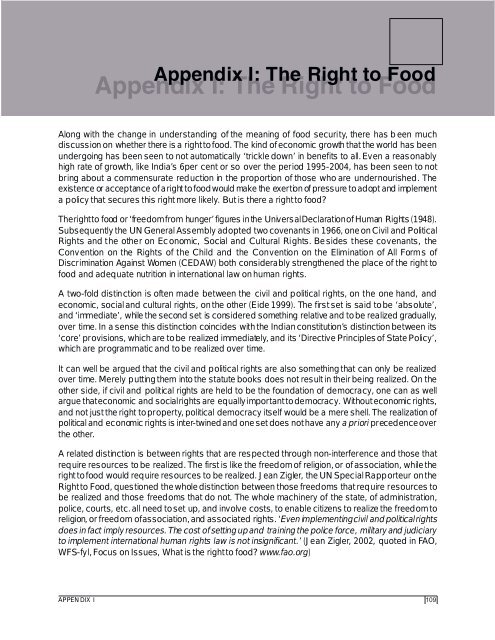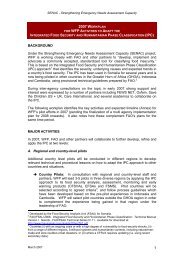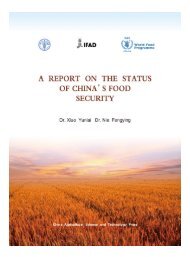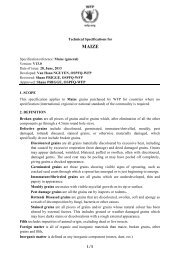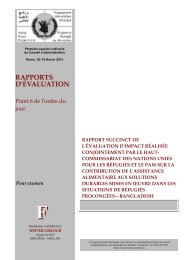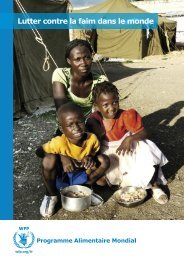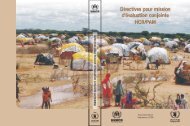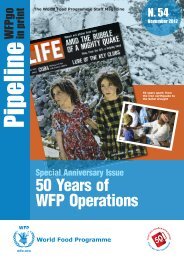Food Security Atlas Of RURAL MAHARASHTRA - WFP Remote ...
Food Security Atlas Of RURAL MAHARASHTRA - WFP Remote ...
Food Security Atlas Of RURAL MAHARASHTRA - WFP Remote ...
Create successful ePaper yourself
Turn your PDF publications into a flip-book with our unique Google optimized e-Paper software.
Appendix I: The Right to <strong>Food</strong>Appendix I: The Right to <strong>Food</strong>Along with the change in understanding of the meaning of food security, there has b een muchdiscussion on whether there is a right to food. The kind of economic growth that the world has beenundergoing has been seen to not automatically ‘trickle down’ in benefits to all. Even a reasonablyhigh rate of growth, like India’s 6per cent or so over the period 1995-2004, has been seen to notbring about a commensurate reduction in the proportion of those who are undernourished. Theexistence or acceptance of a right to food would make the exertion of pressure to adopt and implementa policy that secures this right more likely. But is there a right to food?The right to food or ‘freedom from hunger’ figures in the Universal Declaration of Human Rights (1948).Subsequently the UN General Assembly adopted two covenants in 1966, one on Civil and PoliticalRights and the other on Ec onomic, Social and Cultural Rights. Be sides these covenants, theConvention on the Rights of the Child and the Convention on the Elimination of All Forms ofDiscrimination Against Women (CEDAW) both considerably strengthened the place of the right tofood and adequate nutrition in international law on human rights.A two-fold distinction is often made between the civil and political rights, on the one hand, andeconomic, social and cultural rights, on the other (Eide 1999). The first set is said to be ‘absolute’,and ‘immediate’, while the second set is considered something relative and to be realized gradually,over time. In a sense this distinction coincides with the Indian constitution’s distinction between its‘core’ provisions, which are to be realized immediately, and its ‘Directive Principles of State Policy’,which are programmatic and to be realized over time.It can well be argued that the civil and political rights are also something that can only be realizedover time. Merely putting them into the statute books does not result in their being realized. On theother side, if civil and political rights are held to be the foundation of democracy, one can as wellargue that economic and social rights are equally important to democracy. Without economic rights,and not just the right to property, political democracy itself would be a mere shell. The realization ofpolitical and economic rights is inter-twined and one set does not have any a priori precedence overthe other.A related distinction is between rights that are respected through non-interference and those thatrequire resources to be realized. The first is like the freedom of religion, or of association, while theright to food would require resources to be realized. Jean Zigler, the UN Special Rapporteur on theRight to <strong>Food</strong>, questioned the whole distinction between those freedoms that require resources tobe realized and those freedoms that do not. The whole machinery of the state, of administration,police, courts, etc. all need to set up, and involve costs, to enable citizens to realize the freedom toreligion, or freedom of association, and associated rights. ‘Even implementing civil and political rightsdoes in fact imply resources. The cost of setting up and training the police force, military and judiciaryto implement international human rights law is not insignificant.’ (Jean Zigler, 2002, quoted in FAO,WFS-fyl, Focus on Issues, What is the right to food? www.fao.org)APPEN DIX I109


